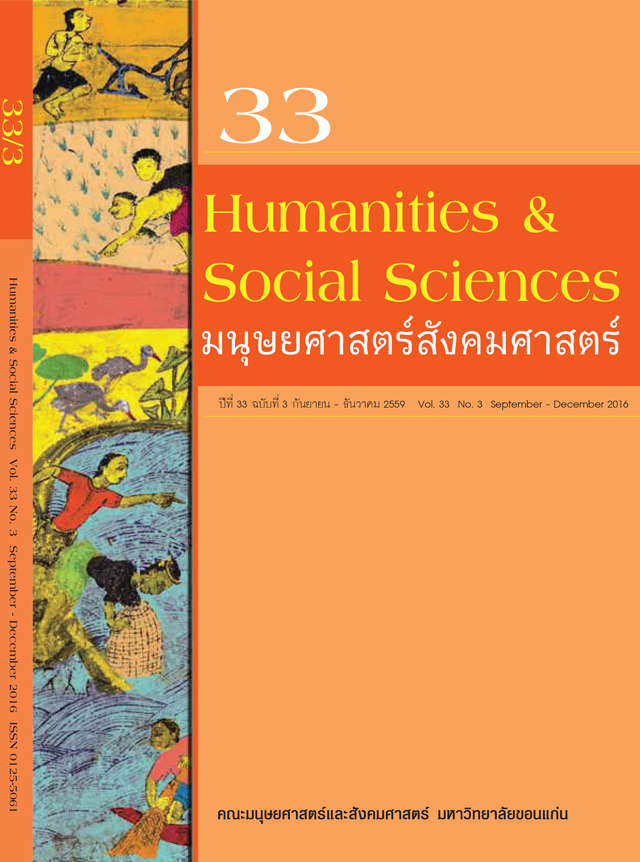การแปลบทพูดกะเทยจากภาษาไทยเป็นภาษาอังกฤษ: กรณีศึกษาภาพยนตร์เรื่อง “สตรีเหล็ก ภาค 1” และหนังสั้นรักจริงปิ๊งเก้อ “Change: รัก...ไม่เปลี่ยน”
Keywords:
การแปลบทพูดกะเทย, การแปลภาษาไทยเป็นภาษาอังกฤษ, บทบรรยายใต้ภาพยนตร์และหนัง, Translation of ladyboys’ dialogues, Translation from Thai into English, SubtitlesAbstract
This study investigates a translation of ladyboys’ dialogues from Thai into English in a movie, the Iron Ladies 1 (2000), and in a true love, fake romance short film, Change: Love…As Always (2013) in terms of their charactersitics in both source text (Thai) and target text (English) as well as translation strategies. By deploying a translation framework of translation strategies of non-equivalence at word level (Baker, 2011), which encompasses idiosyncratic vocabulary used by a specific group of individuals (Suttipong Permpoon, 2013), the results show the 23 examples of ladyboys’ dialogues which include words, phrases, and expressions in which the ladyboy characters use. They are of various characteristics, for example, words, phrases, expressions or slang terms which are newly coined or are adapted from standard language (34.78%) or address terms and pronouns (34.78%). In addition, it is found that the translators translate the ladyboys’ scripts into English by adhering mainly to meaning so that they are suitable to the Thai version. It is also discovered that the translation strategies of non-equivalence are variously employed. For instance, the translation strategy by using more neutral or less expressive words is used the most (26.09%), the translation strategies by cultural substitution and by omission are equally employed (21.74%), and the translation strategies by using a more general word and by paraphrasing share the same percentage of 13.04%. Related translation characteristics, contents, and translation strategies will be further discussed. It is hoped that this study will help translators be aware of unique characteristics of ladyboys’ dialogues and be able to employ different translation strategies of non-equivalence to translate idiosycratic words in ladyboys’ subtitle scripts so as to convey their original meaning and flavor effectively.
บทคัดย่อ
งานวิจัยนี้ศึกษาการแปลบทพูดกะเทยจากภาษาไทยเป็นภาษาอังกฤษในภาพยนตร์เรื่อง “สตรีเหล็ก ภาค 1” (2543) และหนังสั้นรักจริงปิ๊งเก้อ เรื่อง “Change: รัก...ไม่เปลี่ยน” (2556) ในแง่ลักษณะบทพูดกะเทยทั้งต้นฉบับภาษาไทยและฉบับแปลภาษาอังกฤษ รวมถึงกลวิธีการแปล โดยใช้กรอบทฤษฎีการแปลศัพท์เฉพาะวัฒนธรรมของเบเกอร์ (Baker, 2011) ซึ่งยังครอบคลุมถึงศัพท์เฉพาะกลุ่ม (สุทธิพงศ์ เพิ่มพูล, 2556) ผลวิจัยแสดงให้เห็นว่าบทพูดกะเทยซึ่งเป็นคำ วลี และสำนวนต่าง ๆ ที่ตัวละครกะเทยใช้นั้นมีจำนวน 23 ตัวอย่าง ซึ่งมีลักษณะที่หลากหลาย อาทิ คำศัพท์ วลี สำนวน หรือสแลงที่สร้างขึ้นใหม่หรือดัดแปลงจากคำมาตรฐาน (ร้อยละ 34.78) หรือคำเรียกขานและสรรพนาม (ร้อยละ 34.78) และพบว่าผู้แปลบทพูดกะเทยเป็นภาษาอังกฤษจะแปลโดยยึดความหมายเป็นสำคัญโดยให้มีความเหมาะสมกับต้นฉบับภาษาไทย นอกจากนี้ยังมีการใช้กลวิธีการแปลศัพท์เฉพาะกลุ่มที่หลากหลาย เช่น พบกลวิธีการใช้คำที่ให้ความหมายหรือรู้สึกน้อยกว่ามากที่สุด (ร้อยละ 26.09) กลวิธีการใช้ศัพท์วัฒนธรรมและการละคำอย่างละเท่า ๆ กัน (ร้อยละ 21.74) และกลวิธีการใช้คำที่มี ความหมายกว้างและคำที่มีความหมายใกล้เคียงอย่างละเท่า ๆ กัน (ร้อยละ 13.04) เป็นต้น ลักษณะ เนื้อหา และกลวิธีการแปลที่เกี่ยวข้องจะได้รับการอภิปรายเพิ่มเติม หวังว่างานวิจัยชิ้นนี้จะช่วยให้ นักแปลตระหนักถึงบทพูดกะเทยที่มีความหลากหลาย และใช้กลวิธีการแปลศัพท์เฉพาะกลุ่มต่าง ๆ เพื่อถ่ายทอดความหมายและอรรถรสของบทพูดกะเทยในบทบรรยายใต้ภาพยนตร์ได้อย่างมีประสิทธิภาพต่อไป



